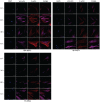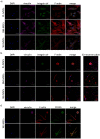Differential adhesion and fibrinolytic activity of mesenchymal stem cells from human bone marrow, placenta, and Wharton's jelly cultured in a fibrin hydrogel
- PMID: 31007888
- PMCID: PMC6460889
- DOI: 10.1177/2041731419840622
Differential adhesion and fibrinolytic activity of mesenchymal stem cells from human bone marrow, placenta, and Wharton's jelly cultured in a fibrin hydrogel
Abstract
Mesenchymal stem cells isolated from different tissues should share associated markers and the capability to differentiate to mesodermal lineages. However, their behavior varies in specific microenvironments. Herein, adhesion and fibrinolytic activity of mesenchymal stem cells from placenta, bone marrow, and Wharton's jelly were evaluated in fibrin hydrogels prepared with nonpurified blood plasma and compared with two-dimensional cultures. Despite the source, mesenchymal stem cells adhered through focal adhesions positive for vinculin and integrin αV in two dimensions, while focal adhesions could not be detected in fibrin hydrogels. Moreover, some cells could not spread and stay rounded. The proportions of elongated and round phenotypes varied, with placenta mesenchymal stem cells having the lowest percentage of elongated cells (~10%). Mesenchymal stem cells degraded fibrin at distinct rates, and placenta mesenchymal stem cells had the strongest fibrinolytic activity, which was achieved principally through the plasminogen-plasmin axis. These findings might have clinical implications in tissue engineering and wound healing therapy.
Keywords: Human mesenchymal stem cells; adhesion; fibrin; fibrinolysis.
Conflict of interest statement
Declaration of conflicting interests: The author(s) declared no potential conflicts of interest with respect to the research, authorship, and/or publication of this article.
Figures







Similar articles
-
Human umbilical cord Wharton's Jelly-derived mesenchymal stem cells differentiation into nerve-like cells.Chin Med J (Engl). 2005 Dec 5;118(23):1987-93. Chin Med J (Engl). 2005. PMID: 16336835
-
Chondrogenic induction of mesenchymal stromal/stem cells from Wharton's jelly embedded in alginate hydrogel and without added growth factor: an alternative stem cell source for cartilage tissue engineering.Stem Cell Res Ther. 2015 Dec 30;6:260. doi: 10.1186/s13287-015-0263-2. Stem Cell Res Ther. 2015. PMID: 26718750 Free PMC article.
-
Endothelium trans differentiated from Wharton's jelly mesenchymal cells promote tissue regeneration: potential role of soluble pro-angiogenic factors.PLoS One. 2014 Nov 20;9(11):e111025. doi: 10.1371/journal.pone.0111025. eCollection 2014. PLoS One. 2014. PMID: 25412260 Free PMC article.
-
Human Wharton's Jelly-Cellular Specificity, Stemness Potency, Animal Models, and Current Application in Human Clinical Trials.J Clin Med. 2020 Apr 12;9(4):1102. doi: 10.3390/jcm9041102. J Clin Med. 2020. PMID: 32290584 Free PMC article. Review.
-
Wharton's jelly derived mesenchymal stromal cells: Biological properties, induction of neuronal phenotype and current applications in neurodegeneration research.Acta Histochem. 2015 May-Jun;117(4-5):329-38. doi: 10.1016/j.acthis.2015.02.005. Epub 2015 Mar 4. Acta Histochem. 2015. PMID: 25747736 Review.
Cited by
-
Aqueous two-phase deposition and fibrinolysis of fibroblast-laden fibrin micro-scaffolds.Biofabrication. 2021 Apr 7;13(3):10.1088/1758-5090/abdb85. doi: 10.1088/1758-5090/abdb85. Biofabrication. 2021. PMID: 33440354 Free PMC article.
-
Expression of CD146 and Regenerative Cytokines by Human Placenta-Derived Mesenchymal Stromal Cells upon Expansion in Different GMP-Compliant Media.Stem Cells Int. 2021 Apr 2;2021:6662201. doi: 10.1155/2021/6662201. eCollection 2021. Stem Cells Int. 2021. PMID: 33868409 Free PMC article.
-
Essential Oil of Bursera morelensis Promotes Cell Migration on Fibroblasts: In Vitro Assays.Molecules. 2023 Aug 26;28(17):6258. doi: 10.3390/molecules28176258. Molecules. 2023. PMID: 37687087 Free PMC article.
-
Hypoxia-Mesenchymal Stem Cells Inhibit Intra-Peritoneal Adhesions Formation by Upregulation of the IL-10 Expression.Open Access Maced J Med Sci. 2019 Dec 11;7(23):3937-3943. doi: 10.3889/oamjms.2019.713. eCollection 2019 Dec 15. Open Access Maced J Med Sci. 2019. PMID: 32165932 Free PMC article.
-
Mechanosensitive regulation of stanniocalcin-1 by zyxin and actin-myosin in human mesenchymal stromal cells.Stem Cells. 2020 Aug;38(8):948-959. doi: 10.1002/stem.3198. Epub 2020 May 19. Stem Cells. 2020. PMID: 32379914 Free PMC article.
References
-
- Falanga V, Iwamoto S, Chartier M, et al. Autologous bone marrow-derived cultured mesenchymal stem cells delivered in a fibrin spray accelerate healing in murine and human cutaneous wounds. Tissue Eng 2007; 13(6): 1299–1312. - PubMed
LinkOut - more resources
Full Text Sources
Other Literature Sources

